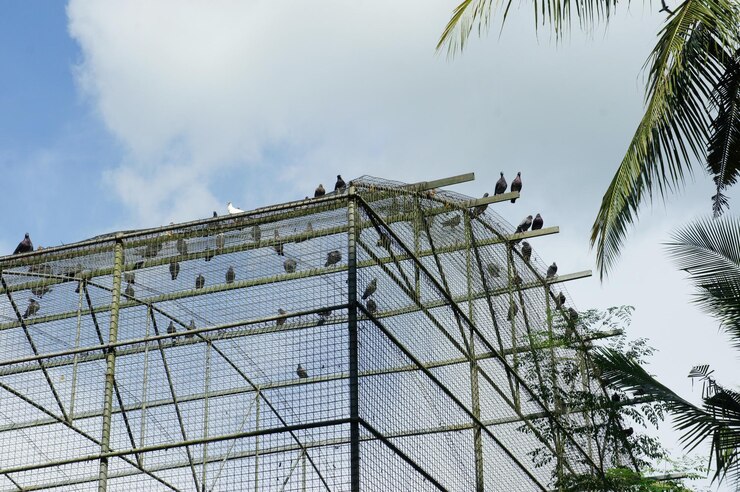Introduction
In today’s urban and industrial landscapes, ensuring safety and cleanliness is more important than ever. Whether it’s a construction site, warehouse, high-rise building, or residential complex, hazards such as accidental falls, falling debris, or nuisance caused by pigeons can create serious problems. This is where industrial safety nets and pigeon nets come into play. These nets are essential preventive solutions designed to protect human life and maintain hygienic conditions by offering robust safety barriers and bird control systems.
In this article, we will explore the importance, applications, benefits, materials, and installation aspects of industrial safety nets and pigeon nets, and why they are critical in modern construction and residential maintenance.
What Are Industrial Safety Nets?
Industrial safety nets are high-strength mesh nets designed to provide fall protection and prevent objects from falling from elevated areas. Commonly used in construction, shipyards, refineries, and large warehouses, these nets safeguard workers and passersby from potential injuries or accidents.
These nets are typically made from high-density polyethylene (HDPE), nylon, or polypropylene, and are treated with UV stabilizers to withstand harsh weather conditions and prolonged outdoor use.
Key Uses:
- Fall protection for workers at construction sites
- Prevention of debris or tools falling from heights
- Cargo netting in warehouses and loading docks
- Equipment and personnel protection in industrial plants
Types of Industrial Safety Nets
- Personnel Safety Nets
Designed to catch workers in case of a fall from scaffolding, ladders, or elevated platforms. - Debris Safety Nets
Installed to catch and contain debris or tools that may fall from a structure, protecting those below. - Facade Safety Nets
Used during exterior building works to protect against the accidental fall of objects or materials. - Cargo Nets
Used to secure loads in transport vehicles or storage areas, especially in logistics and shipping.
These nets are built to meet specific safety standards such as IS 11057 or OSHA regulations, depending on the region and industry.
What Are Pigeon Nets?
Pigeon nets, also known as bird nets, are lightweight but durable mesh nets installed to prevent pigeons and other birds from entering certain areas. While birds may seem harmless, their droppings can damage structures, create unsanitary conditions, and even spread diseases like histoplasmosis, salmonella, and cryptococcosis.
These nets are commonly used in:
- Residential balconies
- Office buildings
- Warehouses and factories
- Food production areas
- AC outdoor units, ducts, and ledges
Made from UV-treated materials, pigeon nets are designed to withstand the elements and provide long-term protection without harming the birds.
Benefits of Industrial Safety Nets
- Enhanced Worker Safety
Industrial safety nets act as life-saving devices, reducing the risk of fatalities and serious injuries due to falls from heights. - Compliance with Safety Regulations
Using safety nets helps industries meet national and international occupational safety standards, thus avoiding legal complications. - Reduced Liability and Insurance Costs
Fewer accidents lead to fewer claims, resulting in lower insurance premiums and better employee morale. - Uninterrupted Workflow
These nets allow work to continue efficiently at heights without fear of tools or materials falling and causing damage or injury.
Benefits of Pigeon Nets
- Bird-Free Zones
Pigeon nets keep birds away from critical areas like air ducts, balconies, and ventilated spaces, ensuring better hygiene. - Protection of Property
Bird droppings are acidic and can corrode paint, metal, and concrete. Installing pigeon nets prevents long-term damage to infrastructure. - Disease Prevention
Pigeon waste can be a breeding ground for harmful bacteria and fungi. Pigeon nets prevent birds from nesting and contaminating surroundings. - Cost-Effective Maintenance
By preventing bird infestation, property owners can avoid frequent cleaning and repairs, saving time and money.
Material and Quality Considerations
Both industrial safety nets and pigeon nets must be made from high-quality, weather-resistant, and durable materials. Some key material properties to look for include:
- UV Resistance: Prevents degradation from sun exposure
- High Tensile Strength: Ensures durability and performance under pressure
- Fire Retardant Coating: In certain industrial safety nets for added protection
- Knotless or Knotted Mesh Design: Depending on the level of strength required
Proper installation by professionals ensures the net is anchored securely and functions effectively without sagging or tearing.
Installation & Maintenance
Installation should be carried out by trained professionals to ensure the netting system meets all safety parameters. For industrial safety nets, installation often involves:
- Scaffolding or suspension systems
- Anchoring at strategic load-bearing points
- Periodic inspections and tension adjustments
For pigeon nets, installation may involve:
- Drilling and fixing stainless steel hooks or nylon anchors
- Using cable ties or wire ropes for tensioning
- Ensuring that no open gaps are left for birds to enter
Maintenance includes regular inspections, especially after storms or extended usage, to check for tears, loosening, or material fatigue.
Conclusion
Both industrial safety nets and pigeon nets play vital roles in improving safety and cleanliness in commercial, industrial, and residential spaces. While industrial safety nets are crucial for protecting workers and the public from falling hazards, pigeon nets help maintain hygiene and prevent property damage caused by birds.
Investing in quality netting systems ensures peace of mind, regulatory compliance, and long-term cost savings. Whether you manage a construction project, a factory, or a residential building, installing the right netting solutions is a smart and essential decision.

